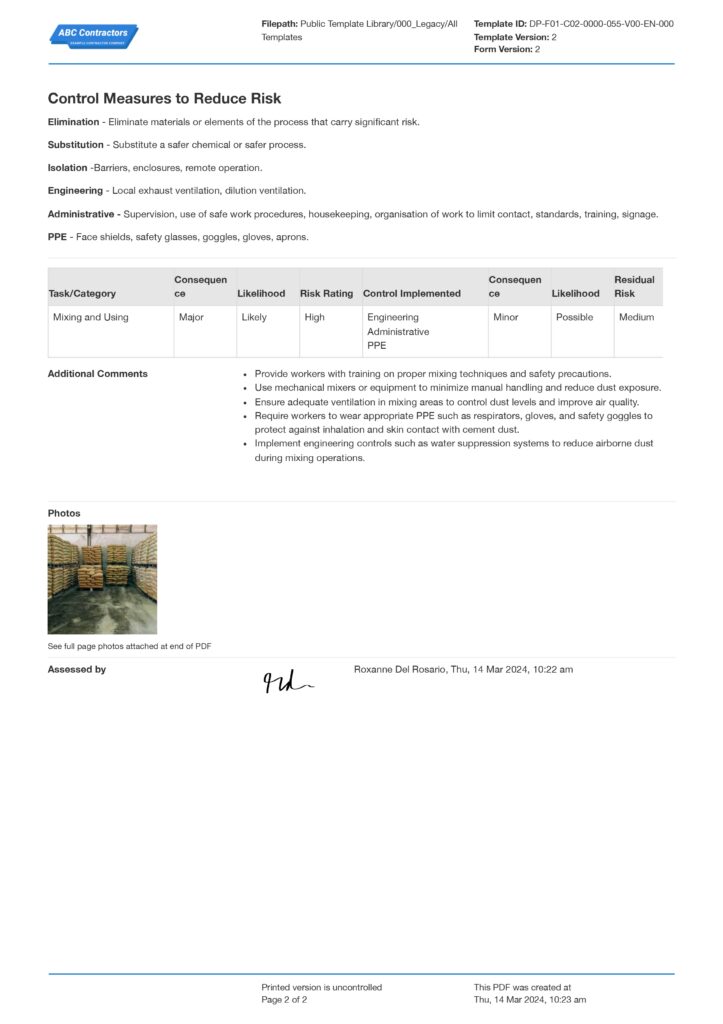Dashpivot Article – Chemical Risk Assessment Example
Chemical Risk Assessment Example
The focus of this article is to provide a chemical risk assessment example, and we also cover the most common harmful chemicals that are used every day in the industry and the exposure limits set by the governing bodies in most countries.

Purpose and importance of chemical risk assessment
The purpose of chemical risk assessment is to evaluate the risks associated on a chemical being used. It is a detailed scientific evaluation that is done by determining its hazardous properties and exposure. Almost all workplaces use chemicals which means any worker can get exposed to paints, spray, inks and toners that when inhaled can cause bad effects to the workers.
The target of chemical risk assessment is to ensure public health and safety, not only those that handles the chemicals but also the consumers. It involves what are the contents of the chemical, what processes are involved and what can happen and how severe it is and assesses how much exposure is too much and can cause harm then what situation and process can cause chemical reaction that poses more danger.
Chemical Risk Assessment is very important as it is an essential part of occupational health & safety, to create awareness to those workers that are at risk, help prevent injuries by implementing a plan of action and add or remove control measures.
Chemical risk assessment involves different steps, but it generally starts with hazard identification, effect of the hazard, and risk categorisation.
Common harmful chemicals that are used in the industry
One of the first few steps of chemical risk assessment is identifying the chemical present to identify the hazards. In this section of the article, we’ll provide some of the most dangerous chemicals that are common in most industries to further solidify the importance of chemical risk assessment.
Construction binders
These are powdered substances that are used to make concrete, mortar or other materials that will become rock-hard strong and solid when mixed with water. Examples to this are: cement, lime and gypsum. Exposure to these chemicals under humid environment is when in contact with the eyes, respiratory tract, and skin.
Resin
These are synthetic plastic material commonly used in adhesives. The most harmful are epoxy resins which are widely used in construction and manufacturing, polyester resins which are used in fiberglass applications and polyurethane resins used for roofing and flooring because of their potentiality to cause skin irritation like dermatitis, allergic reaction, respiratory issues when uncured and when not handled properly.
Mercury
This used in mining especially in artisanal gold mining and silver. These are also used in thermometers, dental fillings, some batteries, light bulbs, skin-lightening cosmetics, disinfectants, and liquid mirror telescope.
Asbestos
This is a fibrous mineral that is resistant to heat and corrosion that is why it’s commonly found in soil and rock formations, and it is being used for insulation, fireproofing, friction products and building materials. Unfortunately, this is a toxic chemical that causes lung cancer, malignant mesothelioma and other serious diseases but is widely used in construction.
Sulfuric Acid
These are found in many places like mining and automotive industry. It is a cheap and easy-to-get liquid that is used to restore exhausted car batteries and in the leather industry. It is one of the chemicals that can cause acid burns, irritate and burn the skin and eyes and may lead to blindness.
Ammonia
This is found in liquid fertilizers, it is used in the producing cotton defoliants and make antifungal agents for fruits. Common in agriculture, but it also can be found in mining and metal manufacturing industries. This can be harmful when inhaled, swallowed, or comes into contact with skin and eyes.
The chemicals listed above are only the most common in some industries. It is important that when using a chemical in any of the process, it must be correctly labeled, Manufacturing Safety Data Sheets (MSDS) are provided by the manufacturer and the risk of exposure is clearly communicated to the workers.
Chemical Exposure Limits
How much exposure is too much exposure? This is one of the fundamental concerns that Chemical Risk Assessments should cover, in instances that it cannot be helped that these toxic chemicals are used in an industry there should be a set limit to it. Laboratory Standards from around the globe like the US Occupational Safety and Health Administration (OSHA), UK Health and Safety Executive (HSE), Safe Work Australia, Canadian Centre for Occupational Health and Safety (CCOHS) has set exposure limits for hazardous substances.
OSHA has HCS (Hazard Communication Standard) that established occupational exposure limits and standards to hazardous chemicals in the workplace. It specifies that manufacturers or importers of the hazardous chemical must provide the information about the chemical they manufacture and import, and it should include what is expected or may occur during normal conditions or unforeseeable emergencies and that this should be noted on the Safety Data Sheet (SDS).
Also, any employer regardless of if they are not the manufacturer of any of the identified hazardous chemical but the chemical is “known to be present” in their operations are required to convey the information on the hazards to their employees.
Employers will have to rely on the SDS provided by the manufacturer. The exposure limit will be provided as OSHA permissible exposure limit (PEL) or American Conference of Governmental Industrial Hygienists (ACGIH) Threshold Limit Value (TLV®)
As an example, OSHA has set Asbestos Exposure Limits. You can find an OSHA asbestos inspection checklist form here for your guidance. This is free and completely customisable.
HSE has set Workplace Exposure Limits requiring employers to protect workers from exposure to hazardous substances. Substances classified as carcinogensor asthmagens must comply with Control of Substances Hazardous to Health Regulations 2002 (COSHH), exposure must be controlled to as low as is reasonably practicable (ALARP). The Workplace Exposure Limits classifies time length of exposure as Long-Term and Short-Term exposure limits according to the nature of the substance and the effects it will cause upon exposure.
CCOHS has a branch called occupational hygiene that specifies the occupational exposure limits (OEL) “indicates the level of admissible exposure, for a length of time (usually 8 hours), to a chemical or physical hazard that is not likely to affect the health of a worker”. You can find an example CCOHS specific risk assessment template here.
Like other regulations, it also standardise the limit according to the chemical properties and the exposure time and uses "Threshold Limit Value" (TLV)® in four categories:
- Time-Weighted Average (TLV-TWA) considerable amount of exposure for the workers over an 8-hour workday and a 40-hour workweek repeated exposure for a working lifetime without adverse effects,
- Short-term exposure (TLV-STEL): entails that there should be a 60-minute interval between exposures
- Ceiling(TLV-C) – means the maximum concentration should not be exceeded during any part of the working exposure.
- Surface Limit (TLV-SL): acceptable concentration that will not likely to result in adverse effects
Safe Work Australia uses Globally Harmonised System (GHS) of Classification and Labelling of Chemicals to communicate chemical properties and dangers through its labels, registers and safety data sheets.
Breakdown of Chemical Risk Assessment and the Proven Chemical Risk Assessment Example
Now that we have a bit of context to the common harmful chemicals found in most industries, let’s walkthrough the parts of a chemical risk assessment example.
Activity Information in the below Chemical Risk Assessment Example
In our example of Chemical Risk Assessment, this is where you indicate the description of the work/activity that this assessment is centered on, what is the location, and which process is the chemical being used. In here we answer the question: “Is chemical classified as hazardous?”, “Is the chemical classified as Dangerous goods?”, or “Is Current MSDS Available?” it will give us specific details about the chemicals. This is the part where the storage or water disposal requirements are also indicated. It’s important that it should comply depending on which governing body your company belong to.
Potential Hazards
This is the part of the assessment where the assessor will identify which part of the body is potential exposed, what is the acute effect, and what is the chronic effect and what are the physical hazards involved. This is where you utilised the guidance set by your respective regulatory organisation regarding exposure limits and the adverse effects when exposed.
Risk Assessment
Risk Assessment is the part of this standardised form that will allow you to indicate what to do upon identifying the condition and the exposure limits. Using a standardised chemical risk assessment form allows you to record all the required information each time you perform an assessment.
Take a look at this sample form below:

Use and customise standardised chemical risk assessment forms for free
Improve your chemical risk assessment management with digital solutions
Individual assessment forms can be difficult to refer during day-to-day activities which limits their effectiveness. Moreover, required chemical risk assessments can be overlooked if there is not a system in place to determine if they have been correctly completed.
Using a chemical risk assessment software provides a scalable solution to these problems. It allows users to create, complete, and access all their risk assessments from any location using a desktop, mobile, or tablet. This allows them to swiftly refer to the assessment if there are any uncertainty over risks and controls of the company when performing the task. An application also allows users to track the progress of their risk assessments. They can be notified of upcoming assessments and see which assessments have been completed or are yet to be fully completed. This helps ensure that assessments are not overlooked before work begins.
Finally, in this article, we went through the purpose of chemical risk assessment, touched on some common harmful chemicals that are used every day in the industry, what are the exposure limits set by the governing bodies in most countries and then breakdown the chemical risk assessment example. In the chemical risk assessment example, we specified each section and while it is not the standard, it is free and by using a software app, you can easily customise it according to your needs.

Material Safety Data Sheet template
Document chemicals and hazardous materials with this comprehensive safety data sheet.

Hazard identification checklist
Complete and organise your daily diaries more efficiently.

Risk Assessment Method Statement (RAMS) template
Customise the Risk Assessment Method Statement (RAMS) template to your project or team needs.


